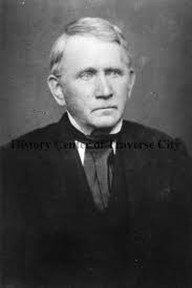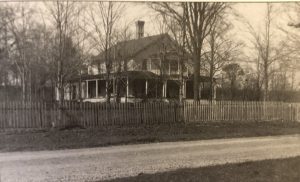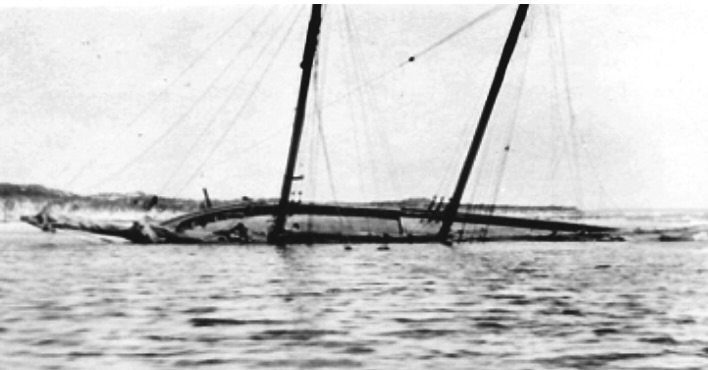This 16-foot by 40-foot partial hull made a reappearance on the Lake Michigan shoreline near the end of the Dune Climb path a few years ago. It is believed to have been from the General Taylor, a wooden steamer that was stranded near Sleeping Bear Point in 1862. It is not known if this was the shipwreck Rev. Dougherty walked to seeking flour, but it could have been. There were many shipwrecks in this area during this time. – Courtesy Historic ipse, Record-Eagle article.
When Rev. Dougherty heard there had been a shipwreck on the shore of Lake Michigan somewhere south of Sleeping Bear Point, he took interest. When he heard that the ship had been loaded with provisions such as flour, and that it was for sale at a “reasonable price” he set out walking from Omena to get all he could.

Reverend Peter Dougherty was a Presbyterian missionary in Omena during the years of 1852-1871. – Courtesy Ruth Craker Collection
In 1852 Rev. Dougherty had carved a mission school out of the woods in Omena. It was successful, 22 boys and 7 girls at the start, increasing to 50 students in the following years. And he had his own growing family to care for, which eventually increased from 5 when he arrived to 9 children. He had to make sure they all had food. Most of his supplies from the Presbyterian Mission and from what they had grown on the mission farm had been used up over that long winter when the bay froze, and the snow lay deep all around them.
So, early one spring morning, Rev. Dougherty set out to walk across the county to get what flour he could from the shipwreck. He first headed to the Indian village of Che-ma-go-bing, near where Leland is today. From there he planned to head south along the shore past what is now called Good Harbor, to Sleeping Bear Bay, now Glen Arbor. He knew his friend John LeRue lived in that region and he knew he could spend a night there.
The walk was long. It was getting dark, and Rev. Dougherty was getting tired, and he had still not reached Mr. Lerue’s cabin. Around 10PM he came to a small shed on the beach where a cooper had been making barrels for the fishermen to ship their fish in. It was very chilly, and he was very tired so he looked around for a place to sleep where he would be warm and dry. He saw two empty barrels missing their tops nearby. With some difficulty, he figured out how to get his head and shoulders into the first barrel and draw the second barrel up using his legs and feet. It could not have been very comfortable, but Rev. Dougherty was tired, and claims he slept well.
The next morning, he was up early and soon found Mr. Lerue’s house. There he learned that the flour had been removed from the shipwreck and taken to Northport, which would have been a lot shorter distance for him to walk had he known it before he left Omena. Mr. Lerue guided him through the woods to Northport so he would not have to go all the way around using the beach to get there.

New Mission Manse – The new mission manse built in 1858 gave the growing Dougherty family a home removed from the Mission boarding school. This photo was taken 19 years after they left, and the house had fallen into disrepair. – Photo ca. 1890 courtesy Omena Historical Society
Still, it took him all day to walk to Northport. Arriving after dark, he was disappointed to learn that the flour had all been sold! After a night’s rest, he returned home empty handed.
It is not hard to imagine Rev. Dougherty’s struggles in the early days of the mission. This is how Sprague described him in his book: “Rev. Dougherty was a graduate of Princeton Theological Seminary. He was a person of strong convictions, energetic and persevering in labor, in manner gentle and pleasing. His life work was well done.” This story of the trip to get flour confirms that.
A lesser man could never have done what he did. Ruth Craker describes him as “a short man, and heavy set, with blue eyes and dark hair. He was a serious person, with a strong willpower, and always worked industriously at his tasks. The Indians gave him a name which was peculiarly fitting. They called him ‘Mickoos,’ which means a small beaver. “He was like the beaver,” they said, “because he does a heap lot o’ work for his size.”
Courtesy “Spragues History of Grand Traverse and Leelanaw Counties” by Elvin L. Sprague, Esq., and Mrs. George N Smith, 1903, and Ruth Craker’s “The First Protestant Mission in the Grand Traverse Region” 1932

